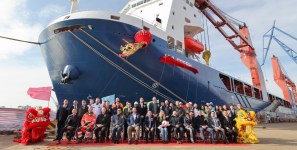The Arctic: A Growing Security and Trade Dilemma
A military strategy for the United States in the Arctic, completed by the Obama administration, is on hold until the Trump administration takes a position on the matter.
The Arctic could prove thorny for Trump because Russia has embarked on an aggressive militarization of the Arctic at the same time Trump wants to forge a relationship with Russian strongman Vladimir Putin to fight the Islamic State in the Middle East.
But the Arctic is not an issue that Trump will be able to ignore for very long. At stake are massive oil and gas reserves and a potentially advantageous northern shipping route that is opening up as climate change ravishes Arctic sea ice. China also appears to be cooperating with Russia in the latter’s aggressive moves up north.
The US military strategy in question was required by the fiscal year 2016 defense authorization bill. Senator Dan Sullivan, a Republican of Alaska, has reviewed the document, although it has yet to be released, and shared some of the conclusions of the unclassified version with an audience at the Center for Strategic and International Studies in Washington last week.
“Over the last two years, Russia has continued its massive buildup of the Arctic,” said Sullivan. Russia has added four new brigade combat teams, a new Arctic command, and 14 new operational airfields, Sullivan said. It’s also added 16 deep-water ports and has 40 icebreakers, with 11 new icebreakers in development. Russia also asserted soverignty to large tracts of the Arctic seabed, claiming they are covered under agreements governing extended continental shelves. A recent Russian Arctic military exercise included 45,000 troops, 3,300 military vehicles, 41 ships, 15 submarines and 110 aircraft, according to Sullivan.
“Clearly, Russia is militarizing the Arctic,” he said. “What’s their end game? To me that’s a really important question.”
The US Geological Survey estimates the Arctic region holds oil and gas reserves equivalent to 412 billion barrels of oil, about 22 percent of the world’s undiscovered oil and gas. Low oil prices and Western sanctions on Moscow have stalled new offshore Arctic projects, “but the Kremlin is playing a longer game,” noted a recent article published by Reuters.
China is also showing a growing interest in the Arctic, particularly as it relates to potential shipping routes, according to Sullivan. Northern routes through the Arctic could save shippers and ocean carriers money by slashing transit times between Asia and Europe and the Americas, as well as reducing fuel consumption. The new northern routes are being made possible by retreating Arctic sea ice, as the ocean warms to record levels.
The unreleased Defense Department strategy does not discuss Chinese interests in the Arctic—an omission Sullivan disagreed with. China has embarked on its own aggressive strategy in the South China Sea, militarizing man-made islands and stepping on the toes of other regional players, in an effort to advance its policy of sharing hegemony in the Pacific region with the United States. The South China Sea represents a major current trade route, transiting trillions of dollars a year worth of goods.
But the document does acknowledge a Russian threat in the Arctic. The document describes “friction points” with Russia in the Arctic, including Russian claims of sovereignty.
“The document identifies what Russia’s national interests are in the Arctic and says clearly that Russia will use Arctic as a natural strategic resource base to support and develop the northern sea route for transportation,” Sullivan said. He added that much of Russia’s activities in the region is about asserting control over northern sea routes. The draft strategy also committed the US military to preserving freedom of the seas in the Arctic.
The document also “identifies a need for enhancing the capability of US forces in the Arctic to defend the homeland and exercise sovereignty,” Sullivan said.
Sullivan is pushing for new naval vessels that are ice-hardened. “They do not all have to be icebreakers,” he said, “but they should have some type of ability to operate in environments with lots of sea ice.”
President Trump will not be able to ignore the defense and trade issues brewing in the Arctic for very long. They’re already on the radar screen of his Secretary of Defense James Mattis, who has described Moscow’s Arctic moves as “aggressive steps.” Trump may want to repair US-Russia ties and team up with Russia in Syria but he may find a bigger geo-political and -economic problem to deal with: Russia and China teaming up against the US in the Arctic and the South China Sea.





Leave a Reply